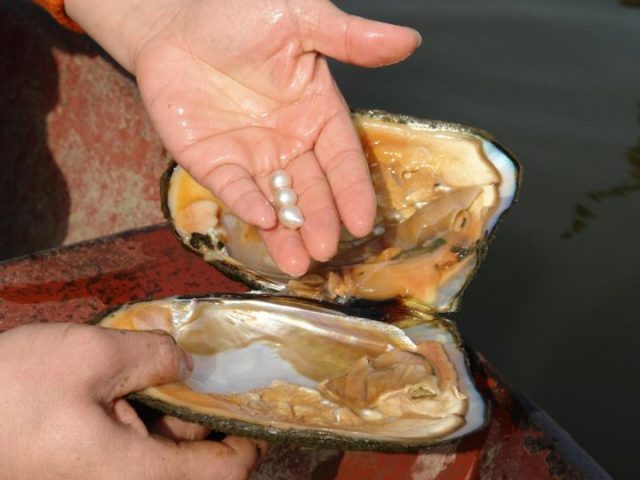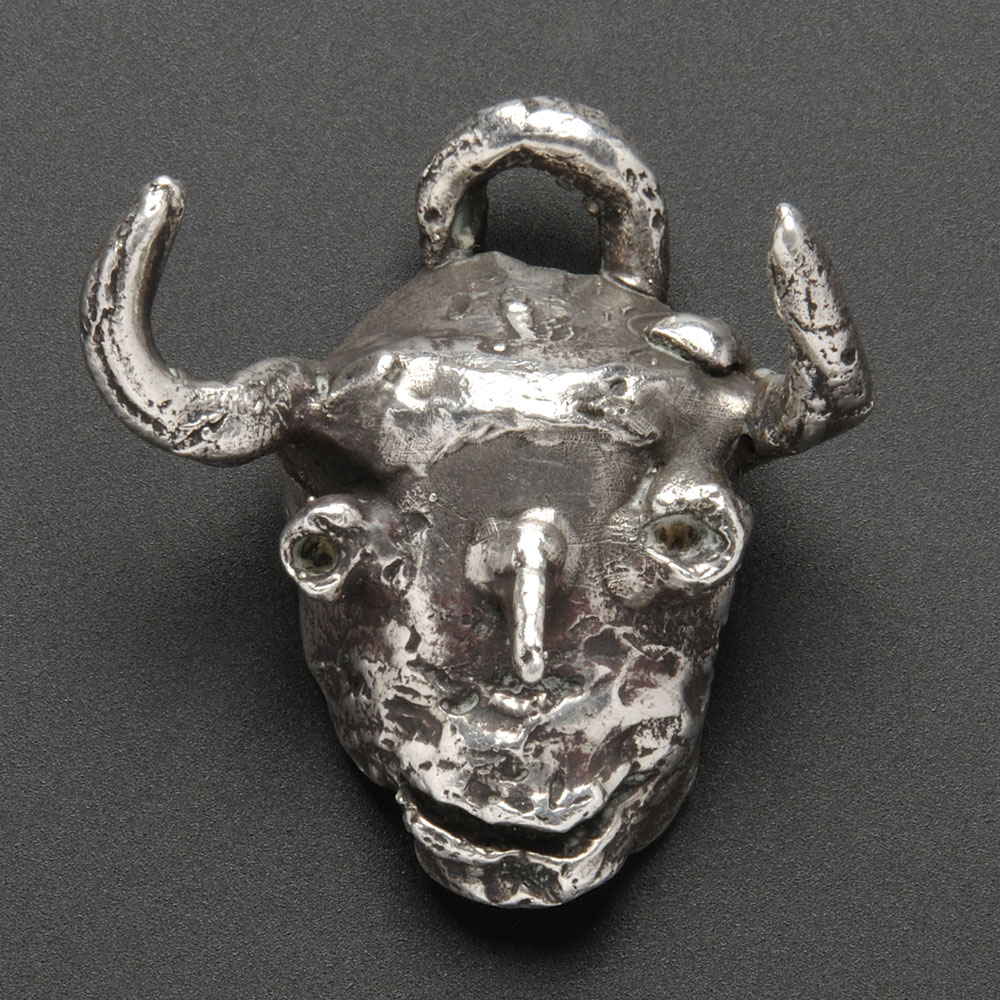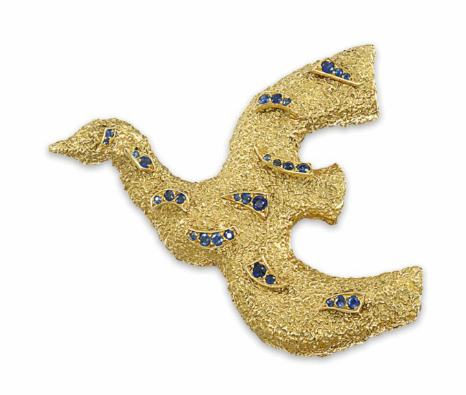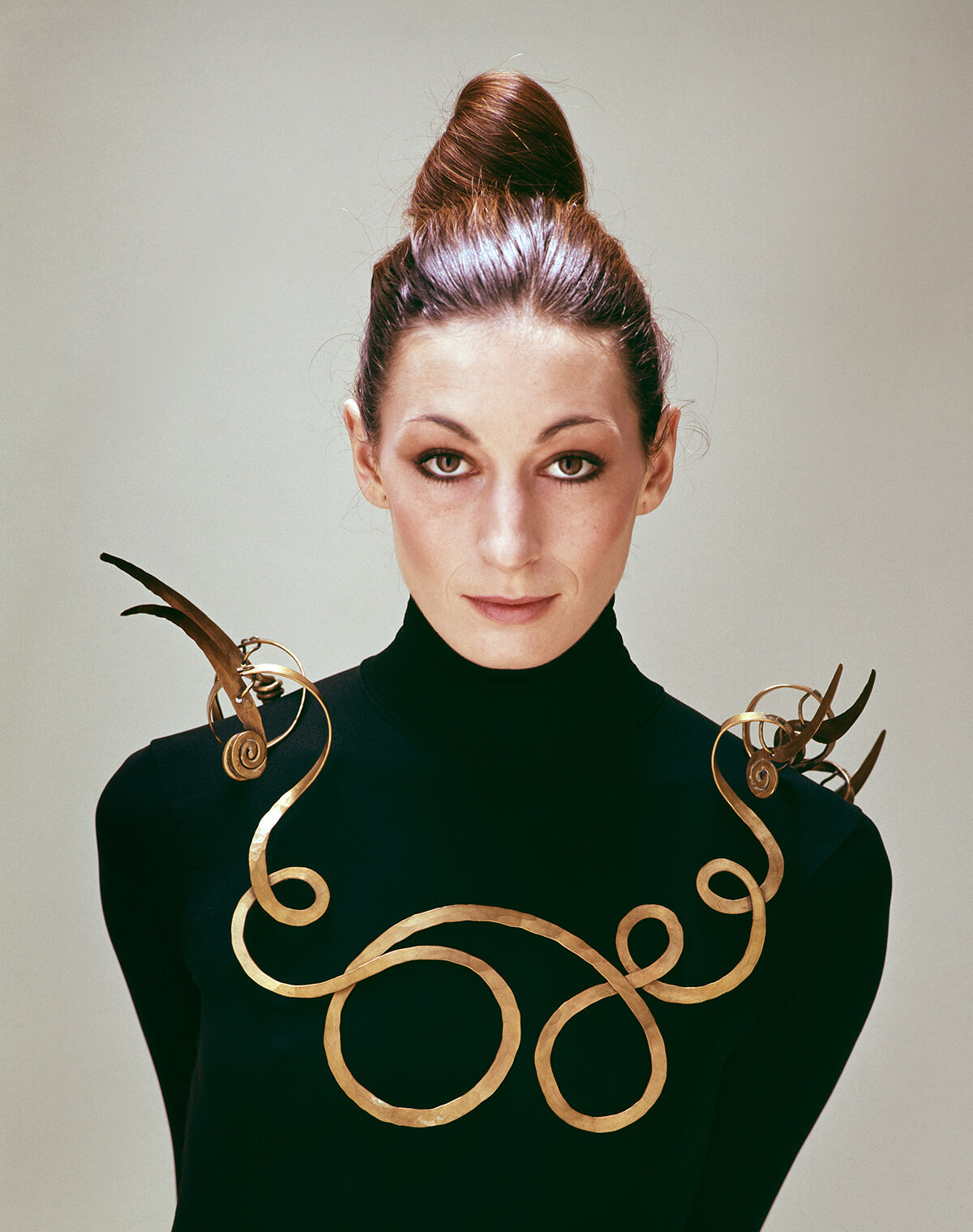talkingfashion » history of fashion jewelry
-
Darling Donatella: Fast Facts about Versace’s First Lady
Darling Donatella: Five Facts about Versace’s First Lady
By Paige McKirahan

In the wake of the gripping Netflix documentary detailing Gianni Versace’s death and Donatella’s rise to the helm of the Versace empire, we felt that the best way to celebrate the incoming Taurus season would be by highlighting this fashion mogul’s amazing career. This Taurus fashionista was born in May 2nd, 1955 in Reggio Calabria, Italy. As the sister of designer Gianni and the daughter of a dressmaker, she was surrounded by strong fashion influences from the start.Being the youngest of four children, she was very close to her siblings despite their great age difference and following the death of her eldest sister at the age of 12, she was the only girl among two boys. Her older brothers made huge impressions on her, and she was self-proclaimed as spoiled as the baby of the family. After the Gianni’s death, she was left to continue the fashion house’s legacy; today, she is the artistic director of the fashion house and the vice president of the Versace company. Being in the spotlight for the majority of her life, we already know a lot of the basic facts about her. But what about the interesting stuff under hiding the surface? Read on to find out some crazy facts about the Queen of Versace herself!
She was going to be a teacher
Prior to her talking over Gianni’s emblematic label, Donatella had plans to become a teacher after her time attending the University of Florence. There, she majored in foreign languages and would often visit Gianni in Milan where he was trying to establish himself in the industry. Her lack of formal fashion training meant nothing to her brother when he trusted her with helping create designs for his fashion house, and as we now know it was her true calling!
Versus, Versace’s sister line, was a gift to her from Gianni

Vintage Versus ad (source)
Versus was launched in 1989 and was created by Gianni in attempt to reach a younger audience. Donatella had proven her design skills tenfold, prompting Gianni to put the brand in her very capable hands. Despite the fact that the line closed in 2005, it was resurrected by Donatella in 2009 in partnership with Christopher Kane and they breathed new life into the now coveted brand!
Gianni is the reason behind her iconic blond locks
Ranking among the likes of Karl Lagerfeld's iconic ponytail, Donatella's sleek blond hair has been the cornerstone of her look since stepping into the industry. This blond bombshell was prompted by none other than Gianni, who's obsession with Patty Parvo pushed him to persuade an eleven-year-old Donatella to dye her hair in to achieve the look that she has kept ever since!
She created Jennifer Lopez's iconic Versace Grammy's dress

JLo and the iconic dress (source)
Donatella was the mastermind behind the 2000 Grammy's dress that essentially broke the internet before Kim K even stepped on the scene; it prompted the creation of Google Image searches, and is considered to be one of the most iconic red carpet dresses of all time! To top it all off, the look was a total accident. Donatella sent the dress to Jennifer before it was finished, with the deep cut being a little too deep for JLo's liking. Quick on her feet, Donatella suggested she use double sided sticky tape to hold it up and VOILA, an icon is born!
She has never sewn a garment
Despite the fact that her mother was a dressmaker, this fashion mogul doesn't sew! That doesn't stop her from designing, of course, and her creative mind paired with her affinity for fashion forward concepts has allowed her to dominate the industry without ever touching a needle!
Donatella is one of the most recognizable faces in the industry and has been for decades, so I'm surprised that I didn't know most of these facts! Did any stun you? We had no idea she was behind JLo's dress, let alone the fact that it was unfinished! Celebrate this icon's birthday by letting your long hair down and wearing what you love, everyday!
Sources:
Donatella Versace. (2019, January 23). Retrieved from https://www.biography.com/people/donatella-versace-21330707Rondon, C. T. (2018, October 08). How Donatella Versace made Google Image a thing (plus 9 more amazing facts about the designer). Retrieved from https://us.hola.com/en/fashion/2018100812819/donatella-versace-facts-biography/ -
Picturesque Pearls: A Style Guide
Picturesque Pearls: A Style Guide
By Paige McKirahan
With wedding season well on its way, we wanted to take a look at one of our favorite elegant motifs in accessories for these upcoming warm weather months. Since pearls first made their way into the realm of jewelry, they have been the true symbol of class and superiority; seeing has how the pearl is the world's oldest gemstone with traces back to 420 BC, this elitist undertone has deep historical roots. In the Byzantine empire, for example, it was dictated that only the emperor was permitted to wear pearls with other societies having similar laws. Until the 20th century, pearls were considered to be one of the most valuable gems on the market all over the globe; prior to this time, all pearls were naturally found in wild mollusks, making them more rare and coveted than ever.

Oldest pearl necklace in existence on display at the Louvre (source)
In ancient Greek culture and at the height of the Roman Empire, pearls were worn on gowns, necklaces, and were even used to decorate furniture in wealthy households. It was even said that Cleopatra preferred pearl jewelry above all others, and she went as far as dissolving one of her most priceless pairs of pearl earrings in a glass of wine before drinking it! This ancient popularity led to pearls being extremely favorable with the monarchy; pearls of all shape and color varieties were widely sought after, and many were coming directly from the Persian Gulf. The 16th century in England was even referred to as the Pearl Age, perfectly reflecting the gemstone's prestige at the time.

Cleopatra Dissolving the Pearl in Wine, Andrea Casali (source)
In the Victorian Age, seed pearls became more favorable than any of their counterparts on account of the fact that their small size made them perfect for jewelry and other accessories. They are typically no larger than 2mm in diameter, and they were widely associated with pure ideals. Royal love of pearls continued for generations, with Queen Victoria having an affinity for all things pearl. Prince Albert gifted her a pair of drop-style pearl earrings in 1847, and these are now owned and proudly worn by the reigning monarch, Elizabeth II.
It wasn't until the late 1800s that pearls became a widely accessible material; in 1893, Kokicho Mikimoto discovered how to create cultured pearls, prompting the creation of over 350 pearl farms across Japan by 1935. This caused a widespread pearl mania that perfectly complemented contemporary culture all throughout the 1900s. From Coco Chanel's iconic 1936 portrait to Audrey Hepburn's emblematic look in Breakfast at Tiffany's, pearls became a true symbol of luxury. This sophisticated aesthetic shifted with Alber Elbaz at the helm of Lanvin, where he reimagined the gemstones as a "cool girl" motif rather than something you would find in your grandmother's jewelry box. He truly spun their reputation into something journalists felt were "not like your mother's pearls", and the gemstone has been present in haute couture ever since.


Coco Chanel and Audrey Hepburn in pearls (source)
Now that we know the history behind the eponymous stone, its time to evaluate the types of pearls. They can now be produced in a variety of different ways, with each having its own special set of characteristics! Whether they are natural or cultured, they are formed when a mollusk produces layers of nacre around molecules inside of the shell. The quality of the nacre is what controls the level of the pearls shine, which can cause it to decrease or increase in value. High-quality pearls should be smooth and blemish free, with shapes ranging from round to misshapen. Misshapen pearls are considered to be baroque, after the art movement. Lastly, a pearl set in necklaces can be uniform with all pearls at the same size, or graduated, meaning they change uniformly from the end to the center. With this education in mind, let's take a look at the specific types of pearls on the market!

(source)
Natural Pearls
Natural pearls are the rarest type, with many historically being found in the Persian Gulf. Though many have already been harvested, you may be able to purchase these small gemstones, but they will cost you a pretty penny!
Cultured Pearls
Cultured pearls are grown in farms, with the mollusks containing them being raised until they reach the point of being able to accept the mother-of-pearl bead nucleus. The pearl technician then implants the bead and returns the mollusk to water to form the gem. Not all cultured pearls are of high quality, and it can take tens of thousands of pearls to compile a group similar enough to use in jewelry.
Saltwater Pearls
Many countries grow cultured pearls in their saltwater seas. Japan and China produce cultured pearls that can range from 2 mm to 10mm in size, and are usually white in color. Australia, Indonesia, and the Philippines produce the largest of all cultured pearls. They are considered the "South Sea pearl" and can get up to 20 mm with colors ranging from white to cream to gold. There are also saltwater pearls grown in the islands of French Polynesia, with their sizes ranging from 8mm to 16mm. They can be naturally black, but they typically can be gray, blue, green, or purple.
Freshwater Pearls
Freshwater pearls mostly hail from China and are grown in lakes, rivers, and ponds all over the continent. Many are white and similar in size to Akoya pearls in size and shape, and usually, have a thicker nacre on account of them not having a bead nucleus.
Imitation Pearls
Imitation pearls usually have a high luster and are coated glass beads. You can tell these apart from cultured or natural pearls, but it may prove to be difficult based upon how the pearls were treated. For tips on how to analyze your pearls, click here!
We hope that this gave you a better insight into all things pearls! We now have a little bit of pearl mania and if you do too, be sure to check out our selection of pearl accessories!
Sources:
Luna, B. (2015, August 10). The History Of Pearl Jewelry. Retrieved from https://www.ritani.com/blog/gemstone-jewels/the-history-of-pearl-jewelry/Perron, C. (2017, December 08). The History and Symbolism of Pearl Jewelry. Retrieved from https://www.brilliantearth.com/news/the-history-and-symbolism-of-pearl-jewelry/N/A. (2018, June 08). The Evolution of Pearl Jewelry in Fashion. Retrieved from https://www.crfashionbook.com/fashion/a21098608/pearl-jewelry-fashion-history/ -
Jewelry as an Art Form
Jewelry as an Art Form
By Paige McKirahan
Fashion, as well as many other venues of design, has begun to blur the line between what is art and what is not; as jewelry is created and designed with many of the similar processes as sculptures and paintings, we would be foolish to not deem these pieces as a form of artistic expression. Jewelry can be the main visual event in any ensemble, fascinating the eyes and overloading the senses in a way that the David by Michelangelo may enthrall a museum patron at the Galleria dell'Accademia. There are so many artists and jewelry designers alike that have created wearable art that falls into neither (or both!) the fashion or fine art categories, creating a new form that appeals to all facets of the industry. Now you may be left asking “who are these designers?”, so we here at TalkingFashion have prepared a dazzling list of these artists that are sure to pique your interest and prepare you for the fast approaching MET Gala this May.
You likely know this artist for his industry-altering contributions to the art world, but many people do not know he experimented with many different medias; from sculptures to jewelry, he was truly the jack of all artistic trades. His one of kind pieces are few and far between, and their eclectic composition and mysterious existence make these works highly sought after. His most popular motifs include satyrs, minotaurs, bulls, and bullfighting, with his other pieces including imagery relevant to who he created the piece for.

Silver “Satyr” Pendant, Pablo Picasso (source)
This patron of the surrealist movement has roots in the fashion industry through multiple high-profile collaborations with designers like our beloved Schiaparelli. In 1941, he invited Coco Chanel’s jewelry designer, Duke Fulco di Verdura, to discuss a collaboration that turned into a tremendous success. Many of the pieces mimicked Dali’s paintings with a refined opulence that turned their wearers into works of art themselves! Most of these works are now on display at the Dali Museum in Spain, and he summarized these jeweled masterpieces like this: “To history, they will prove that objects of pure beauty, without utility but executed marvelously, were appreciated in a time when the primary emphasis appeared to be upon the utilitarian and the material.”

An array of Dali jewelry pieces (source)
This sculptor and jewelry designer has made huge waves in the fashion industry with his art jewelry and collaborations with Geoffrey Beene, Kansai Yamamoto, Calvin Klein, Anne Klein, Karl Lagerfeld, Michael Kors and Donna Karan. His true claim to fame was a 1976 Vogue cover; the magazine featured his work in their publication over a period of 7 years in 49 consecutive issues. He is the first fine jewelry designer to receive the first jewelry designer to ever be awarded the Geoffrey Beene Lifetime Achievement Award from the Council of Fashion Designers of America (CFDA), and his contribution to the art world has gained him many other high profile partnerships and industry nominations!

Robert Lee Morris piece on the cover of Vogue (source)
As a pioneer of the cubist movement alongside the other highly revered artist-turned designer Picasso, Braque is considered to be one of the most dynamic artists of the 20th century. He treated his jewels as if they were miniature sculptures, with each possessing their own personality. He commonly including natural motifs that depicted humans, fish, horses, and birds, and were considered to be some of the most beautiful fine jewelry creations of their time. His most well-known collection uses the image of a bird in flight throughout multiple jewelry styles, and they bring in tens of thousands of dollars in auctions across the globe!

Georges Braque, 1960s (source)
Calder, who is most famous for his creation of the mobile, is an iconic sculptor who stunned the art world when he began creating his larger than life mobile jewelry pieces. His affinity for abstraction and casual grandeur shined through in his designs, and he created over 2000 works including pieces for famous friends Joan Miró and Peggy Guggenheim. His wire-shaped works are considered to be wearable sculptures and can take any look to a new level.

Alexander Calder necklace (source)
If these artists have piqued your interests and you would like to see some of this art in action, check out this list of museums that will allow you to get up close and personal with these beautiful works!
Sources:
Cain, A. (2016, December 23). Salvador Dalí Made Jewelry That Could Turn You into a Surrealist Artwork. Retrieved from https://www.artsy.net/article/artsy-editorial-salvador-dali-made-jewelry-that-could-turn-you-surrealist-artworkCain, A. (2017, August 21). Alexander Calder's Jewelry Turns People into Living Sculptures. Retrieved from https://www.artsy.net/article/artsy-editorial-alexander-calders-jewelry-turns-people-living-sculpturesN.a.(2016, May 06). Art as jewellery - 10 wearable masterpieces | Christie's. Retrieved from https://www.christies.com/features/jewellery-by-artists-from-Braque-to-Bury-7333-1.aspxRobert Lee Morris. (2019, March 24). Retrieved from https://en.wikipedia.org/wiki/Robert_Lee_MorrisSkinner Inc. (n.d.). Retrieved from https://www.skinnerinc.com/news/blog/pablo-picasso-jewelry/ -
Presidents Day’s Presidential Jewels
Presidents Day’s Presidential Jewels
By Paige McKirahan
As the shortest month of the year with the most to celebrate, February is chock full of fun events worth commemorating. From fashion week to Valentine’s Day to Black History Month, it is easy to get lost in the sea of dedications and themed sale emails flooding your inbox. One of the biggest sale holidays of the year just so happens to occur during this festive month, and is approaching fast on the 18th! Presidents Day, which is a federal holiday set to honor America’s long line of presidents, is more than just a day off of work perfectly suited for shopping.
At its conception, the holiday was originally designated to recognize George Washington’s birthday on February 22nd, 1732; when it was first initiated in 1879, it was only to be observed by Washington D.C. federal offices. Then, in 1885, it expanded to include all federal offices and established itself as the first holiday formed to celebrate a president. Though it once was celebrated on Washington’s exact birthday, the date has been changed to always fall on the third Monday in February and now aims to honor all presidents throughout history.

Early President's Day Posting (source)
In addition to the celebration of our country's leaders, Presidents Day is also used as an opportunity to award those qualifying with a Purple Heart military medal. Revived on Washington’s 200th birthday in 1932, this prestigious award is commonly given out on the holiday at both the federal level and at individual military posts.
In terms of executive- inspired accessories, the most common presidential motifs are primarily seen on coins integrated into a piece's design. Coins are versatile, malleable, and easily accessible so incorporating them into accessories and jewelry has been a long standing practice not only in the United States, but all over the world. From belts to bracelets, coins offer an easy way to show your patriotism while keeping it fashion forward. For more coin accessories, check out our collections and honor our country's rich history in style! For more presidential pieces, head over to the National Archives store to shop and support National Archives exhibits!
Sources:
AncestralFindings.comWill Moneymaker founded Ancestral Findings back in 1995. He has been involved in genealogy research for over 20 years. The thrill of the hunt. “The History of Presidents Day.” Ancestral Findings, 5 Mar. 2018, ancestralfindings.com/presidents-day/.
-
Fur in Fashion: Faux Pas or Fabulous?
Fur in Fashion: Faux Pas or Fabulous?
By Paige McKirahan
One material that has been on trial in fashion court for decades is one that was, for a large portion of its life, associated with high status and class. Fur accessories and clothing have been in circulation for 170,000 years and were used as a status symbol in as early as the 11th century. European royalty sported fur coats, capes, and accessories commonly made from mink, sable, and chinchilla fur. This increase in fur wearing prompted the creation of laws that regulated which social classes were permitted to wear specific furs. Prior to this, furs were more so used out of utility; the real pelts offered warmth and comfort to people in primitive cultures, starkly contrasting their new popularized purpose.
As the desire for luxury furs increased over the next five centuries, so did the development of fur farms. In the Victorian era, we saw a rise in popularity with both genders as the use of furs in movies put a spotlight on the wild textile. Coats worn by men tended to be lined with fur with other materials covering the outside of the piece. Women’s coats boasted fur accents throughout at the collar, wrists, and hems. We also saw the popularity of dress and shoe clips begin to inflate in the same period; these accessories were either adorned with fur details or accessorized the fur pieces themselves.

Victorian Era Furs
(photo credits to grandladies.com)
Other accessories that loved fur fun were scarves, shawls, and hats. Looking back at their basic use surrounding warmth, people used fur to accessorize cold weather outfits in style. These small hints of luxury could elevate any look and were sure to illustrate the wearers high status.
The 1900s brought big change to the fur industry as imitation furs began to take over the market. Real furs were expensive and many fashionistas, especially animal rights activists, associated them with cruelty. As technology improved, so did the quality of fake furs created from silk and synthetic pile fabrics. Designers began to create more casual looks using fur, moving away from glamour and more towards department store chic. The ’50s and ‘60s saw fur be more affordable than ever, with faux fur options being front and center on account of Old Hollywood influence.

1950s Fur Ad
(photo credits to vintagedancer.com)
Now, fur is still one of the most widely debated fabrics in the industry and and increased amount of high profile brands are declaring themselves as fur free. The ‘90s pushed the faux v. real fur debate and used iconic supermodels as spearheads for the movement away from a fur-filled future. Fendi seems to be at the center of this debate as their haute couture counterparts seem to be ahead in the faux fur conversation; Gucci and Versace have vowed to ditch the real thing, while Fendi continues to unapologetically create pieces with real animal fur. Whatever style you prefer, we encourage you to research furs and the benefits of both styles before deciding on a side! Remember to wear what you love, and find fur items you love in our collection!




